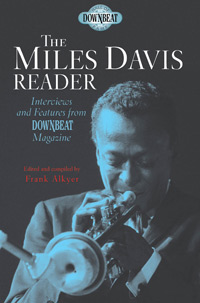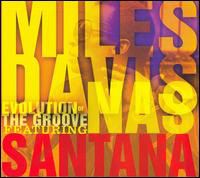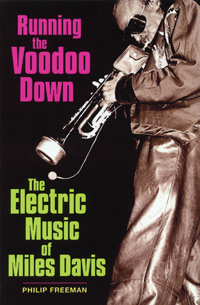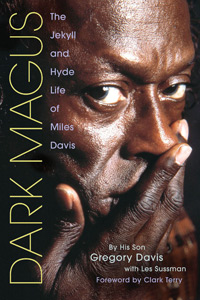• The Miles Davis Reader: Interviews and Features from Downbeat Magazine, edited by Frank Alkyer, Hal Leonard
• Running the Voodoo Down: The Electric Music of Miles Davis, by Philip Freeman, Backbeat Books
• Dark Magus: The Jekyll and Hyde Life of Miles Davis, by Gregory Davis and Les Sussman, Backbeat Books
• Miles Davis: The Complete On The Corner, Columbia/Legacy
• Miles Davis: Evolution of the Groove, Columbia/Legacy
 Over the course of his career, Miles Davis changed the face of jazz repeatedly. From post-war bebop right up to his death in 1991, he was at the forefront of a number of movements. In many cases, it’s not so much that the music he produced was ahead of it’s time, as it was simply timeless. Bop, ballad, or the funk-drenched groove, Miles was the master of them all.
Over the course of his career, Miles Davis changed the face of jazz repeatedly. From post-war bebop right up to his death in 1991, he was at the forefront of a number of movements. In many cases, it’s not so much that the music he produced was ahead of it’s time, as it was simply timeless. Bop, ballad, or the funk-drenched groove, Miles was the master of them all.
That he lived large – and hard – is indisputable. Without a doubt he played up his almost mythical status, yet in the end, we’re left with the music, and as testament to his talent, it continues to shine bright.
Davis-related books and CDs continue to fill shelves, with some recent, stellar examples.
By any measure the Sony/Legacy metal box series – which documents his years with Columbia Records – is a phenomenal undertaking. Every set in this comprehensive series includes essential music, essays, sessionographies and more.
 The Complete On The Corner is the last of nine box sets. It’s certainly one of his more controversial releases; when it was first released in 1972, On The Corner was greeted with confusion, and many cases, outright hostility; especially from the jazz community. Sitar and Tablas groove alongside funky electric bass, wah wah guitar and trumpet, predating trance, world music, and drum ‘n bass by decades.
The Complete On The Corner is the last of nine box sets. It’s certainly one of his more controversial releases; when it was first released in 1972, On The Corner was greeted with confusion, and many cases, outright hostility; especially from the jazz community. Sitar and Tablas groove alongside funky electric bass, wah wah guitar and trumpet, predating trance, world music, and drum ‘n bass by decades.
Sessions began with many of the musicians mystified; unsure of what was going on and where Miles was headed with this dense new sound. A few players from previous bands were back – including Chick Corea and John McLaughlin – yet more than ever before, Miles had discarded his past. Instead, the primary influences were German composer Karlheinz Stockhausen and the funk of James Brown and Sly Stone.
Tracks were assembled in piecemeal fashion, with severe edits, loops and more – in many cases, techniques that would show up years later in hip-hop – long after the musicians went home. Long-time producer Teo Macero was vital to the finished product. Splicing and manipulating tape as far back as In A Silent Way, by now his innovative methods were as identifiable as Miles’ own playing.
The box contains six discs, and spans 16 recording sessions, which produced On The Corner, plus Big Fun and Get Up With It two years later, along with more than two hours of previously unreleased music. Easily one of the highlights of the year.
Evolution of a Groove is a five-track EP of remixes, sampling from a variety of performances spanning 1959–1972. The disc is aimed at making Davis’ music more appealing to contemporary tastes; but it’s hard to make this more revolutionary that it already is – sure, one track adds a rapper, yet Miles already did that himself, on his final album, 1991’s Doo Bop. The source material is incredibly resilient, and manages to come across as strong as ever even in this context. It works well enough as a pleasant diversion, but is hardly essential listening.
 The Miles Davis Reader collects sixty years of coverage from Downbeat Magazine on Miles, including features going all the way back to 1950, when he was a sideman with Charlie Parker. Surprisingly, Miles defends Dixieland music in his first-ever interview with the magazine – and again five years later in one of the magazine’s famous blindfold tests. 1955 also brought news of Miles being in the midst of a comeback – the first of many.
The Miles Davis Reader collects sixty years of coverage from Downbeat Magazine on Miles, including features going all the way back to 1950, when he was a sideman with Charlie Parker. Surprisingly, Miles defends Dixieland music in his first-ever interview with the magazine – and again five years later in one of the magazine’s famous blindfold tests. 1955 also brought news of Miles being in the midst of a comeback – the first of many.
The inclusion of then-current reviews and feature articles shows exactly how each album was received, without revisionist history. Tellingly, On the Corner was given only two stars; the reviewer criticizing the lack of soloing and questioning whether the elongated grooves were nothing more than ‘repetitious boredom.’ Three months earlier, the magazine had awarded a collection of Miles’ work from ‘49-‘50 five stars.
Set up chronologically, Richard Cook’s It’s About Time offers insight and historical perspective as he examines every release – including bootlegs – in Miles’ vast catalogue. Forgotten gems are uncovered, and he isn’t afraid to point out the discs that didn’t work, and why. One fascinating example; the terms of Miles’ mid-eighties contract with Warner Brothers goes a long way to explaining the lackluster albums that resulted.
 It’s About Time was Cook’s final work before his untimely passing last year – he was the co-author of the massive Penguin Guide to Jazz Recordings, as well as his own Jazz Encyclopedia, and his knowledge and enthusiasm will be missed.
It’s About Time was Cook’s final work before his untimely passing last year – he was the co-author of the massive Penguin Guide to Jazz Recordings, as well as his own Jazz Encyclopedia, and his knowledge and enthusiasm will be missed.
 Running the Voodoo Down sticks with the electric phase, from Bitches Brew on. Author Freeman admits his musical diet consisted of metal and rap when he first discovered Davis’ music in the late 80’s. Not surprisingly, it was On The Corner that got him hooked. Owing to a distinct lack or historical context – Freeman references acts like Skinny Puppy, Bad Brains and Tom Waits as often as jazz players – there’s an entirely new perspective throughout much of the book. For fans of Miles’ electric phase, it’s an enjoyable – and, at times illuminating – read.
Running the Voodoo Down sticks with the electric phase, from Bitches Brew on. Author Freeman admits his musical diet consisted of metal and rap when he first discovered Davis’ music in the late 80’s. Not surprisingly, it was On The Corner that got him hooked. Owing to a distinct lack or historical context – Freeman references acts like Skinny Puppy, Bad Brains and Tom Waits as often as jazz players – there’s an entirely new perspective throughout much of the book. For fans of Miles’ electric phase, it’s an enjoyable – and, at times illuminating – read.
While the other books here are primarily concerned with the music, Dark Magus barely touches on it. Gregory Davis – Miles’ son – promises in the introduction to bring no sour grapes and a minimum of emotional baggage. That’s debatable – much time spent on why Gregory was cut out of his father’s will – but some family history is interesting; Miles’ father distrust of white folk bordered on psychotic. It interesting to learn more about his relationships with Charlie Parker, Dizzy Gillespie and John Coltrane, but there’s little in the way of fresh insight. And, for all his gripes, as far as negative portraits, Miles’ notoriously unreliable autobiography is still by far the harshest.